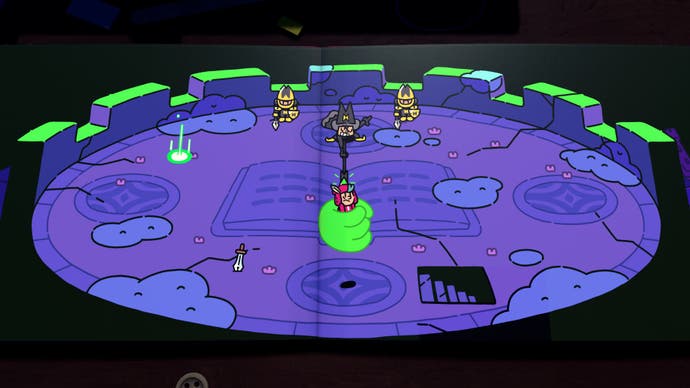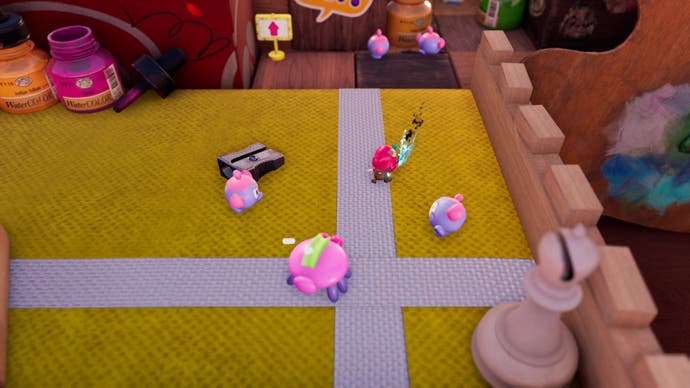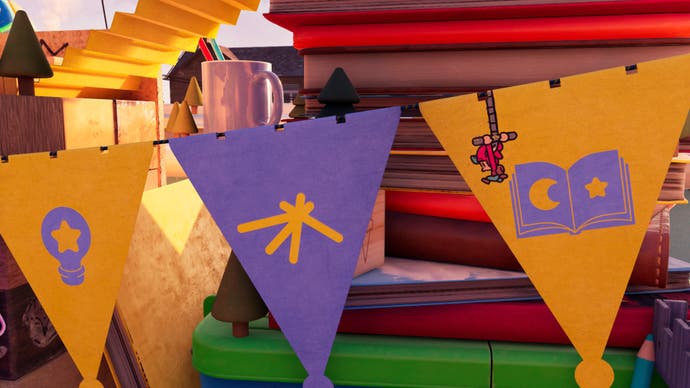The Plucky Squire offers familiar ideas in a lovely new arrangement

The special, almost intangible loveliness of the Plucky Squire isn’t down to either the game design itself or the way it’s presented. It’s down to both of these things, combined so thoroughly, and with such imagination, that it’s hard to stir them apart.
To put it another way, it’s not just that this is a fantasy-action game in which your hero receives a bow and arrow from a beautiful elf. It’s that, to win that bow and arrow, the hero first has to venture across the authentic wilderness of a child’s cluttered bedroom desk, and into a cardboard castle. There, at the top of a tower formed by a stack of beloved books, the hero and the elf must do battle inside the stiff confines of a knock-off Magic: The Gathering card.
This completely rules. And that’s just one moment from the preview build of the game I’ve been playing over the last few days that has elicited such a gasp of wonder and delight. A battle inside a battling card! And then I walk away from it with a golden bow. Yes please, Plucky Squire. Yes please.
The Plucky Squire has been firmly locked in my imagination since its unveiling, which I think was at a not-E3 a while back. In the midsts of the sequels and bloodshed conjured by so many of the briefing shows, here was a thrilling glimpse of something else – something airy and playful and delightfully innocent. The Plucky Squire is a character in a children’s book, and his adventures seemed to play out in that book. One page might be a forest filled with slimes. The next moment the page might turn over and the new spread would reveal the approach to a castle. To move amongst the illustrations on an actual page, to battle and puzzle your way through a world of ink – that was gorgeous enough.
But it was only ever half the idea. Because every now and then The Plucky Squire gets knocked out of the pages of the book completely. (I can now tell you he initially gets pushed out by an evil wizard, which makes a lot of sense, frankly.) Suddenly he’s a 2D fantasy hero in a 2D fantasy world no longer. He’s a 3D stranger in a world of over-size domestic delights: pencil sharpeners, paint sets, paperclips and Post-it notes. It’s nursery land designed by Claes Oldenberg. He’s stealthing around actual real-world bugs and working out how to climb mountains made of wooden blocks.


It’s almost too much. Whenever this happens – the adventure takes the Plucky Squire back and forth between the pages of the book and the expanses of bedroom desk – I always think the same thing: this is almost too much. So it’s worth remembering that, even when you’re still in the book, safe in a world that the Plucky Squire understands, there’s still a lot going on.
There’s a concept treasured amongst people who write children’s books – I got it from watching a talk by Mac Barnett – called “meaningful page turns.” Basically, a good writer will try to make the act of turning the page really count. What’s on the other side? A surprise, an upset, a thing you absolutely did not see coming.
Well. The Plucky Squire is really good at this stuff. Firstly you’ll be walking towards a castle, say, and then the next page will give you the castle, its doors open wide. Already great. But then one page will send you battling goblins or what-have-you from a top-down perspective, and then you’ll work your way to a series of steps leading underground and – meaningful page turn – you’ll be underground, exploring the dark, a shadow moving amongst shadows, all side-on, suddenly caught in the act of a 2D platformer.


Shades of Zelda 2! This is extremely pleasing. But it’s only the start. Maybe a bridge is out and you need to get across. The narrator of the book – a constant presence in the game, sort of in line with the elegant understated tone of the Stanley Parable narrator in his calmer moments – will have written the text on the page. The bridge is broken. But maybe you can pluck up that word, “broken” and find another word to replace it with, from somewhere else in the book. The bridge is “giant”. The bridge is “rock”. There must be something here you can use to get across, and in the world of children’s literature, words have real impact on everything else on the page.
This is the kind of complexity you’re dealing with by the time you’re first sent out of the book and into the desktop world that’s waiting beyond it. And now things only grow in intricacy. You can carry objects between worlds, shifting them between the 2D and the 3D. So a dice might be just lying on the desk in 3D land, but could be perfect for weighting down a switch back in the book. A bounce pad might belong in the 3D world where it will help you get up some blocks, but to reach those blocks you’ll need to slip into 2D for a bit with it and work your way through some children’s art pasted to the side of a desk.

The points at which you travel between worlds are fixed and highlighted by a green spiral, but there’s still a freedom here as you work out what to do and what not to do in each scenario. And even when The Plucky Squire settles into its rhythm it still varies things a lot. Stealth, now a puzzle, now defeat all the bugs nearby. Now 2D, now 3D. Now a boss battle. And onwards.
Onwards! That’s the real magic here. I’m still early on in the game, but in both of its worlds, I want to see what comes next. I want to see where the adventure in the children’s book leads, and I want to know what else awaits me out on that expanse of child’s desk. I’m in. And I can’t wait for more.




